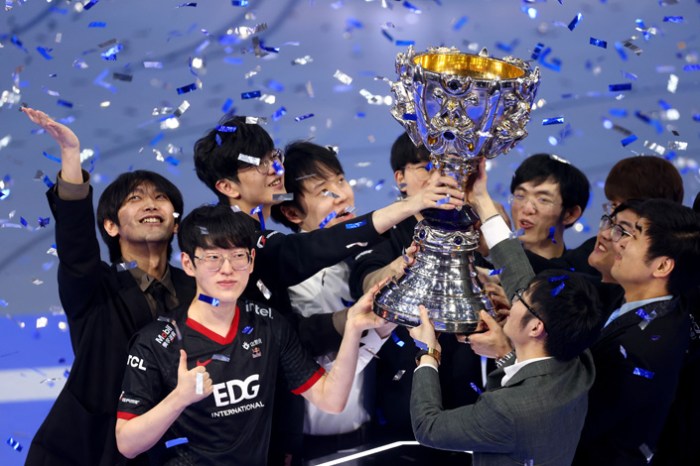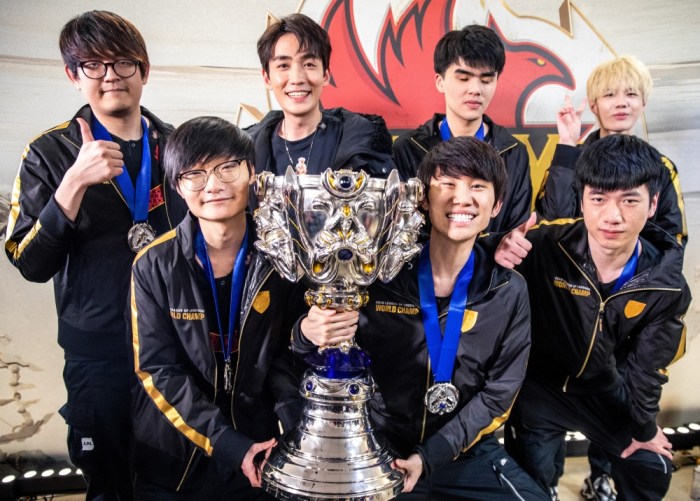Esports championships have exploded onto the scene, transforming from basement LAN parties into global spectacles. Think massive stadiums packed with screaming fans, millions watching online, and prize pools bigger than some small countries’ GDPs. This isn’t just gaming; it’s a full-blown industry, a cultural phenomenon, and a serious competition with athletes at the top of their game. We’ll explore the history, the biggest games, the organization, the impact, and what the future holds for this electrifying world.
From the early days of
-Street Fighter II* tournaments to the modern behemoths like
-League of Legends* Worlds and
-The International* for Dota 2, we’ll trace the evolution of competitive gaming, highlighting key moments and analyzing the factors that have driven its incredible growth. We’ll also delve into the business side of things, looking at how teams, sponsors, and organizers work together to create these massive events.
History of Esports Championships

Esports championships have exploded in popularity, transforming from small gatherings of passionate gamers to massive, globally televised spectacles. This evolution reflects not only the growth of gaming itself but also the increasing sophistication of the industry’s infrastructure, marketing, and professionalization. The journey from humble beginnings to the multi-million dollar industry we see today is a fascinating one, marked by significant milestones and dramatic shifts in scale and impact.
The early days of competitive gaming were characterized by local area network (LAN) parties. These events, often held in basements or small venues, provided a space for gamers to compete against each other in person. While prize pools were modest, if they existed at all, the passion and camaraderie were palpable. These early LAN parties laid the foundation for the organized competitive scene that would eventually emerge.
Early LAN Parties and the Rise of Organized Competition
The transition from informal LAN parties to organized esports championships was gradual but significant. Games like
- StarCraft*,
- Quake*, and
- Counter-Strike* emerged as early pioneers, attracting dedicated communities and fostering the development of professional players. Early tournaments, often sponsored by hardware manufacturers or game publishers, provided a platform for these players to showcase their skills and compete for small but increasingly valuable prizes. The growth of online gaming further fueled this trend, allowing players from across the globe to connect and compete, paving the way for truly international events.
Significant Esports Championship Milestones
Several key milestones marked the evolution of esports championships. The formation of professional leagues and organizations provided structure and legitimacy to the competitive scene. The rise of streaming platforms like Twitch and YouTube dramatically increased viewership, transforming esports into a spectator sport with a massive global audience. Landmark events like the Evolution Championship Series (Evo) for fighting games and The International for
Dota 2* significantly boosted prize pools and viewership, demonstrating the enormous commercial potential of esports.
Prize Pools and Viewership Across Eras
The growth of esports championships is dramatically illustrated by the escalating prize pools and viewership figures. In the early 2000s, prize pools were often in the thousands of dollars, and viewership was limited to those present at the event or those who could find low-quality online streams. Today, major championships routinely boast prize pools in the millions, and viewership numbers reach tens of millions, rivaling or exceeding those of traditional sports events.
This exponential growth reflects not only the increasing popularity of esports but also the substantial investment from sponsors, publishers, and investors.
Growth of Prize Money in Major Esports Championships (Last Decade)
| Year | The International (*Dota 2*) | League of Legends World Championship | Evo Championship Series (Fighting Games) |
|---|---|---|---|
| 2014 | $1,000,000 | $2,130,000 | $100,000 (estimated) |
| 2018 | $25,530,000 | $6,450,000 | $200,000 (estimated) |
| 2022 | $18,208,300 | $2,225,000 | $250,000 (estimated) |
| 2023 | Data unavailable | Data unavailable | Data unavailable |
Note: Prize pool data is subject to change and may vary depending on the source. Estimated figures are used for Evo due to less readily available historical data. Data for 2023 is not yet available as of this writing.
Popular Esports Championship Games

Esports has exploded in popularity, with millions of viewers tuning in to watch professional gamers compete in various titles. Several games consistently dominate the esports championship landscape, attracting massive prize pools and passionate fan bases. Their enduring appeal stems from a combination of exciting gameplay, high skill ceilings, and compelling narratives built around professional teams and individual players.The following section will explore five of the most popular esports championship games, delving into their unique mechanics, competitive strategies, and the distinct skill sets and team dynamics they demand.
League of Legends Gameplay and Competitive Strategies, Esports championships
League of Legends (LoL), a Multiplayer Online Battle Arena (MOBA), requires strategic team composition, precise execution of abilities, and effective communication. Teams of five players battle to destroy the opposing team’s base, utilizing a diverse roster of champions with unique abilities and playstyles. Competitive strategies often involve intricate macro-level decision-making, such as map control, objective securing (like Baron Nashor or dragons), and teamfighting positioning.
Micro-level skill, including precise last-hitting of minions for gold and quick reaction times in combat, is also crucial.
Dota 2 Gameplay and Competitive Strategies
Dota 2, another popular MOBA, shares similarities with LoL but boasts a higher skill ceiling and more complex gameplay. Its heroes possess a wider range of abilities, leading to a greater diversity of strategies and playstyles. The game rewards intricate team coordination and a deep understanding of itemization and counter-picking. Competitive strategies often revolve around controlling the map’s neutral objectives, securing powerful items, and exploiting enemy weaknesses through precise team compositions and skillful execution.
Counter-Strike: Global Offensive Gameplay and Competitive Strategies
Counter-Strike: Global Offensive (CS:GO), a first-person shooter (FPS), demands precise aim, tactical awareness, and excellent teamwork. Two teams, Terrorists and Counter-Terrorists, engage in rounds based on objectives like planting or defusing a bomb. Competitive strategies involve map knowledge, economic management, and utilizing various tactical approaches, including aggressive rushes, calculated pushes, and defensive strategies. Individual skill, particularly aiming and movement, is paramount, but teamwork and communication are vital for success.
Overwatch Gameplay and Competitive Strategies
Overwatch, a team-based hero shooter, emphasizes diverse character roles and coordinated team play. Players choose from a roster of heroes with unique abilities, each fulfilling a specific role (tank, damage, support). Competitive strategies revolve around effective team composition, map control, and capitalizing on ultimate abilities. Individual skill, particularly aiming and game sense, is important, but successful play relies heavily on teamwork and effective communication.
Call of Duty Gameplay and Competitive Strategies
Call of Duty (various iterations), a fast-paced FPS, prioritizes quick reflexes, accurate aim, and strategic map awareness. Teams engage in intense firefights, utilizing various weapons and tactical maneuvers. Competitive strategies often involve aggressive map control, coordinated pushes, and exploiting map knowledge. Individual skill is paramount, especially in terms of aim and movement, but strong communication and teamwork are also key to success.
Player Skill and Team Dynamics Across Games
The skill sets and team dynamics required for success vary significantly across these five games. MOBAs like LoL and Dota 2 emphasize strategic thinking, macro-level decision-making, and complex team coordination. FPS games like CS:GO and Call of Duty prioritize individual mechanical skill, precise aim, and quick reflexes, although effective teamwork remains essential. Hero shooters like Overwatch demand a balance of individual skill and coordinated team play, with players needing to adapt their strategies based on the composition of their team and the opposing team.
Comparison of Competitive Scenes
The following bullet points compare the competitive scenes of three popular esports titles: League of Legends, Dota 2, and Counter-Strike: Global Offensive.
- League of Legends: Boasts a massive global following, highly organized leagues (like the LCS and LCK), and significant prize pools. The meta (the current best strategies) evolves relatively quickly, demanding constant adaptation from players and teams.
- Dota 2: Known for its incredibly high skill ceiling, intense international competition (The International), and a more independent, less regionally centralized structure than LoL. The meta shifts more slowly compared to LoL.
- Counter-Strike: Global Offensive: Features a strong global presence, with numerous regional leagues and major championships. The game emphasizes individual skill, resulting in more emphasis on individual player recognition, but strong teamwork is still crucial for success.
FAQ: Esports Championships
What are the common injuries in esports?
Repetitive strain injuries like carpal tunnel syndrome and tendonitis are common due to prolonged gameplay. Eye strain and back problems are also prevalent.
How do esports athletes train?
Training involves intense practice sessions, strategic analysis, team scrimmages, and physical fitness routines to maintain focus and dexterity.
Are esports players considered athletes?
The debate continues, but many argue that the dedication, skill, and physical demands of professional esports warrant athlete status.
How much money can esports players make?
Earnings vary wildly, from modest salaries to millions in prize money and sponsorships for top players.
What are the ethical concerns in esports?
Match-fixing, doping (performance-enhancing drugs), and issues around fair play and game integrity are major concerns.
